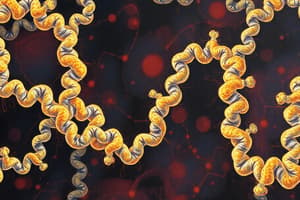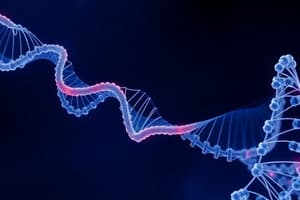Podcast
Questions and Answers
What defines the primary structure of a protein?
What defines the primary structure of a protein?
- The arrangement of multiple polypeptide chains.
- The folding patterns of the polypeptide chain.
- The unique sequence of amino acids in a polypeptide chain. (correct)
- The three-dimensional shape of the protein.
Which interactions play a significant role in forming tertiary structure?
Which interactions play a significant role in forming tertiary structure?
- Iron bonds and hydrogen bonds.
- Hydrophobic interactions and covalent bonds.
- Hydrogen bonds and ionic bonds. (correct)
- Ionic bonds and peptide bonds.
How does secondary structure arise in proteins?
How does secondary structure arise in proteins?
- From the assembly of multiple polypeptides.
- From the folding of the polypeptide chain into helices or sheets. (correct)
- From the unique sequence of nucleotides in DNA.
- From the interactions between amino acid side chains.
What characterizes quaternary structure in proteins?
What characterizes quaternary structure in proteins?
What can result from alterations in the primary structure of a protein?
What can result from alterations in the primary structure of a protein?
Which type of secondary structure is characterized by parallel or anti-parallel strands?
Which type of secondary structure is characterized by parallel or anti-parallel strands?
What is the role of peptide bonds in protein synthesis?
What is the role of peptide bonds in protein synthesis?
What may cause protein denaturation?
What may cause protein denaturation?
What common feature is shared by proteins that require tertiary structure and are composed of multiple subunits?
What common feature is shared by proteins that require tertiary structure and are composed of multiple subunits?
How does the flexibility of the polypeptide backbone affect protein structure?
How does the flexibility of the polypeptide backbone affect protein structure?
Flashcards
Primary Structure
Primary Structure
Linear sequence of amino acids in a polypeptide chain, determined by gene nucleotides.
Secondary Structure
Secondary Structure
Folding of polypeptide chains into structures like α-helices and β-pleated sheets, stabilized by hydrogen bonds.
Tertiary Structure
Tertiary Structure
Three-dimensional arrangement of a polypeptide, determined by interactions between amino acid side chains.
Quaternary Structure
Quaternary Structure
Signup and view all the flashcards
Polypeptide Flexibility
Polypeptide Flexibility
Signup and view all the flashcards
Polypeptide Synthesis
Polypeptide Synthesis
Signup and view all the flashcards
Protein Denaturation
Protein Denaturation
Signup and view all the flashcards
α-helix
α-helix
Signup and view all the flashcards
Hydrophobic Interactions
Hydrophobic Interactions
Signup and view all the flashcards
Disulfide Bridges
Disulfide Bridges
Signup and view all the flashcards
Study Notes
Polypeptide Structure
- A polypeptide chain is a sequence of amino acids (aa) linked by peptide bonds (-CO-NH-).
- The chain has an amino terminus (N-terminus) and a carboxyl terminus (C-terminus).
- The sequence of aa is crucial, as even minor changes can alter the protein's 3D structure and function.
- Peptide bonds link aa, but the groups around them (side-chains) can rotate, providing flexibility.
Polypeptide Flexibility
- The polypeptide backbone is flexible due to the rotation of groups around the peptide bonds.
- Torsion angles relate to the rotation around these bonds.
- Three torsion angles are formed between the intersecting covalent bonds.
- Chemical groups on the aa side-chains also influence flexibility.
Protein Structures
- Proteins have four levels of structural organization.
- Primary: The linear sequence of amino acids. It's determined by the DNA sequence, unique to each protein type.
- Secondary: 3D shapes formed by folding of the primary structure.
- Alpha-helices and beta-pleated sheets are stabilized by hydrogen bonds between the backbone N-H and C=O groups.
- Turns and random coils are also important secondary structural elements.
- Tertiary: The overall 3D shape of the entire polypeptide chain.
- This shape is stabilized by interactions between R-groups (side-chains).
- Interactions include hydrogen bonds, hydrophobic interactions, ionic bonds, and disulfide bonds (important: covalent).
- Quaternary: The arrangement of multiple polypeptide chains in a protein complex.
- This structure, involving multiple subunits, is held together by weak bonds and affects protein function.
Protein Denaturation
- Denaturation is the loss of a protein's 3D structure.
- It is caused by physical factors (e.g., high temperature) or chemical agents (e.g., pH changes).
- Denaturation can disrupt the secondary, tertiary, and sometimes quaternary structure.
- The protein loses its function if its structure is changed.
Studying That Suits You
Use AI to generate personalized quizzes and flashcards to suit your learning preferences.




